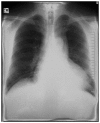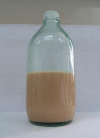Primary chylopericardium: A case report and literature review
- PMID: 29375697
- PMCID: PMC5763741
- DOI: 10.3892/etm.2017.5383
Primary chylopericardium: A case report and literature review
Abstract
Primary chylopericardium (CP) is a rare clinical condition in which chylous fluid containing high concentrations of triglyceride accumulates in the pericardial cavity. The present study reports a case of CP that was successfully treated by reconstruction surgery of thoracic duct. To improve the ability to diagnosis and treat this rare disease, the current study also systematically extracted 104 reported cases of primary or idiopathic CP from the past 60 years (January 1950 to December of 2015), and reviewed the clinical manifestation, etiology, diagnosis and treatment of these cases. The age at diagnosis varied between 6 weeks and 79 years with a mean age of 27.95±16.50 years. Asymptomatic patients accounted for 39.42% of cases, while the most common initial symptoms were dyspnea (44.23%) and coughing (10.58%). Jugular venous distention and distant heart sound was identified in 23 (22.12%) and 34 cases (32.69%), respectively. Cardiomegaly in X-ray scans was detected in the majority of patients (93.27%). In addition, lymphoscintigraphy and lymphangiography were helpful in identifying the source of chyle. Regarding the etiology, idiopathic cases accounted for 35.56% of the included cases in the present study. The most important cause of primary CP was abnormal connection or accumulation of lymph fluid in the pericardium (37.50%). Conservative therapy included low-fat or medium-chain triglyceride diet, as well as total parenteral nutrition. The majority of patients (71.2%) required surgery for definitive therapy, and thoracic duct ligation was the most preferred surgical procedure, performed in 44.23% of cases. Follow-up was reported in 64 cases, and all patients survived during the mean follow-up period of 12 months. Therefore, it is suggested that surgical management is the most successful treatment method and is associated with a favorable prognosis.
Keywords: idiopathic chylopericardium; lymphatic malformation; primary chylopericardium; review.
Figures




References
-
- Hasebroek K. Analyse einer chylösen pericardialen Flüssigkeit (Chylopericardium) Biol Chem. 1888;12:289–294. (In German)
LinkOut - more resources
Full Text Sources
Other Literature Sources
Miscellaneous
